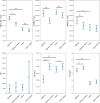Heart rate dynamics for cognitive load estimation in a driving simulation task
- PMID: 39738154
- PMCID: PMC11685601
- DOI: 10.1038/s41598-024-79728-x
Heart rate dynamics for cognitive load estimation in a driving simulation task
Abstract
Cognitive load (CL) is one of the leading factors moderating states and performance among drivers. Heavily increased CL may contribute to the development of mental stress. Averaged heart rate (HR) and heart rate variability (HRV) indices are shown to reflect CL levels in different tasks. The aim of this large-scale study was to explore how accurately HR and HRV metrics can differentiate between varying CL conditions during driving. Participants (N = 892, 44% female, from 18 to 79 years old) performed simulated driving in highway and urban scenarios. The n-back task was used as a mental distraction to further increase CL. The results have shown that increased CL was accompanied by higher HR, lower HRV, as measured by RMSSD, and higher HR complexity, as measured by permutation entropy. HR displayed the highest accuracy in discriminating between short windows (30 s) of different CL conditions, particularly highway versus urban driving and mental distraction during highway driving. We found gender and age effects on discriminative accuracy of HR and HRV metrics which were related to subjective ratings of CL. These results illustrate that HR and HRV indices provide a valid source for applications in the field of CL monitoring and mental stress detection.
Keywords: Cognitive load; Driving simulation; Heart rate; Heart rate variability; Mental stress.
© 2024. Harman International Industries, Incorporated 2024.
Conflict of interest statement
Declarations. Competing interests: The authors declare no competing interests.
Figures



Similar articles
-
Classifying metro drivers' cognitive distractions during manual operations using machine learning and random forest-recursive feature elimination.Sci Rep. 2025 Mar 4;15(1):7564. doi: 10.1038/s41598-025-92248-6. Sci Rep. 2025. PMID: 40038461 Free PMC article.
-
Functional near-infrared spectroscopy in the evaluation of urban rail transit drivers' mental workload under simulated driving conditions.Ergonomics. 2019 Mar;62(3):406-419. doi: 10.1080/00140139.2018.1535093. Epub 2019 Jan 27. Ergonomics. 2019. PMID: 30307379
-
Driving in an urban environment, the stress response and effects of exercise.Ergonomics. 2018 Sep;61(9):1273-1281. doi: 10.1080/00140139.2018.1468494. Epub 2018 May 3. Ergonomics. 2018. PMID: 29681228 Clinical Trial.
-
The short-term effects of artificially-impaired binocular vision on driving performance.Ergonomics. 2021 Feb;64(2):212-224. doi: 10.1080/00140139.2020.1814427. Epub 2020 Sep 4. Ergonomics. 2021. PMID: 32841064
-
Detecting driver fatigue using heart rate variability: A systematic review.Accid Anal Prev. 2022 Dec;178:106830. doi: 10.1016/j.aap.2022.106830. Epub 2022 Sep 22. Accid Anal Prev. 2022. PMID: 36155280
Cited by
-
Classifying metro drivers' cognitive distractions during manual operations using machine learning and random forest-recursive feature elimination.Sci Rep. 2025 Mar 4;15(1):7564. doi: 10.1038/s41598-025-92248-6. Sci Rep. 2025. PMID: 40038461 Free PMC article.
-
Toward Wearable MagnetoCardioGraphy (MCG) for Cognitive Workload Monitoring: Advancements in Sensor and Study Design.Sensors (Basel). 2025 Aug 5;25(15):4806. doi: 10.3390/s25154806. Sensors (Basel). 2025. PMID: 40807970 Free PMC article.
References
-
- Engström, J., Markkula, G., Victor, T. & Merat, N. Effects of cognitive load on driving performance: The Cognitive Control Hypothesis. Hum. Factors59, (2017). - PubMed
-
- Warm, J. S., Parasuraman, R. & Matthews, G. Vigilance requires hard mental work and is stressful. Human Factors 50 Preprint at (2008). 10.1518/001872008X312152 - PubMed
-
- Hjortskov, N. et al. The effect of mental stress on heart rate variability and blood pressure during computer work. Eur. J. Appl. Physiol.92, (2004). - PubMed
Publication types
MeSH terms
LinkOut - more resources
Full Text Sources

